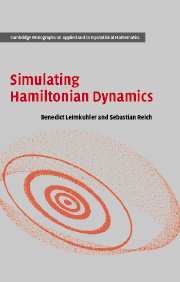Book contents
- Frontmatter
- Contents
- Preface
- Acknowledgements
- 1 Introduction
- 2 Numerical methods
- 3 Hamiltonian mechanics
- 4 Geometric integrators
- 5 The modified equations
- 6 Higher-order methods
- 7 Constrained mechanical systems
- 8 Rigid body dynamics
- 9 Adaptive geometric integrators
- 10 Highly oscillatory problems
- 11 Molecular dynamics
- 12 Hamiltonian PDEs
- References
- Index
10 - Highly oscillatory problems
Published online by Cambridge University Press: 04 December 2009
- Frontmatter
- Contents
- Preface
- Acknowledgements
- 1 Introduction
- 2 Numerical methods
- 3 Hamiltonian mechanics
- 4 Geometric integrators
- 5 The modified equations
- 6 Higher-order methods
- 7 Constrained mechanical systems
- 8 Rigid body dynamics
- 9 Adaptive geometric integrators
- 10 Highly oscillatory problems
- 11 Molecular dynamics
- 12 Hamiltonian PDEs
- References
- Index
Summary
Hamiltonian systems often exhibit dynamical phenomena covering a vast range of different time scales. In this chapter, we will discuss systems with two well separated time scales. More specifically, we consider systems for which the fast motion is essentially oscillatory. Such systems can arise from very different applications such as celestial or molecular dynamics and they might manifest themselves in very different types of Hamiltonian equations. Hence, the discussion in this chapter is necessarily limited to special cases. However, the basic principles and ideas have a much wider range of applicability.
A standard integrator, whether symplectic or not, will, in general, have to use a stepsize that resolves the oscillations in the fast system and, hence, one might be forced to use very small timesteps in comparison to the slow dynamics which is of primary interest. However, in special cases, one might be able to individually exactly solve the fast oscillatory and the slow system. Following the idea of splitting methods, this suggests to compose these two exact propagators and to apply a stepsize that is large with respect to the period of the fast oscillations. Such a method is then called a large timestep (LTS) method. Often the fast oscillations cannot be integrated analytically. A natural idea for the construction of an LTS method is then to assign different timesteps to different parts of the system. This approach is called multiple timestepping (MTS) and can often even be implemented such that the overall timestepping procedure still generates a symplectic map. We will explain the basic idea of symplectic LTS/MTS methods in Section 10.1.
- Type
- Chapter
- Information
- Simulating Hamiltonian Dynamics , pp. 257 - 286Publisher: Cambridge University PressPrint publication year: 2005



